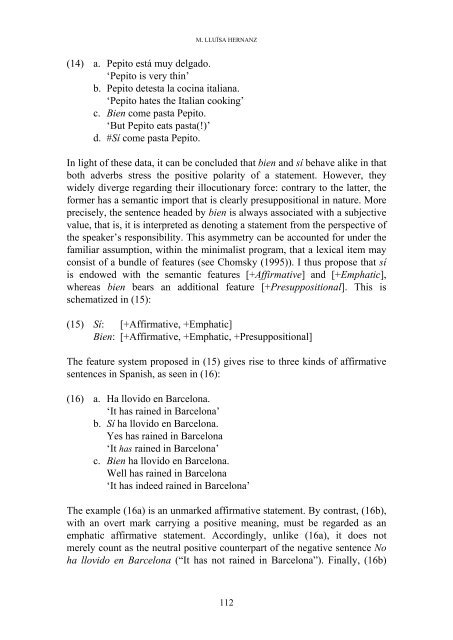Emphatic Polarity and C in Spanish - Lear
Emphatic Polarity and C in Spanish - Lear
Emphatic Polarity and C in Spanish - Lear
Create successful ePaper yourself
Turn your PDF publications into a flip-book with our unique Google optimized e-Paper software.
M. LLUÏSA HERNANZ<br />
(14) a. Pepito está muy delgado.<br />
‘Pepito is very th<strong>in</strong>’<br />
b. Pepito detesta la coc<strong>in</strong>a italiana.<br />
‘Pepito hates the Italian cook<strong>in</strong>g’<br />
c. Bien come pasta Pepito.<br />
‘But Pepito eats pasta(!)’<br />
d. #Sí come pasta Pepito.<br />
In light of these data, it can be concluded that bien <strong>and</strong> sí behave alike <strong>in</strong> that<br />
both adverbs stress the positive polarity of a statement. However, they<br />
widely diverge regard<strong>in</strong>g their illocutionary force: contrary to the latter, the<br />
former has a semantic import that is clearly presuppositional <strong>in</strong> nature. More<br />
precisely, the sentence headed by bien is always associated with a subjective<br />
value, that is, it is <strong>in</strong>terpreted as denot<strong>in</strong>g a statement from the perspective of<br />
the speaker’s responsibility. This asymmetry can be accounted for under the<br />
familiar assumption, with<strong>in</strong> the m<strong>in</strong>imalist program, that a lexical item may<br />
consist of a bundle of features (see Chomsky (1995)). I thus propose that sí<br />
is endowed with the semantic features [+Affirmative] <strong>and</strong> [+<strong>Emphatic</strong>],<br />
whereas bien bears an additional feature [+Presuppositional]. This is<br />
schematized <strong>in</strong> (15):<br />
(15) Sí: [+Affirmative, +<strong>Emphatic</strong>]<br />
Bien: [+Affirmative, +<strong>Emphatic</strong>, +Presuppositional]<br />
The feature system proposed <strong>in</strong> (15) gives rise to three k<strong>in</strong>ds of affirmative<br />
sentences <strong>in</strong> <strong>Spanish</strong>, as seen <strong>in</strong> (16):<br />
(16) a. Ha llovido en Barcelona.<br />
‘It has ra<strong>in</strong>ed <strong>in</strong> Barcelona’<br />
b. Sí ha llovido en Barcelona.<br />
Yes has ra<strong>in</strong>ed <strong>in</strong> Barcelona<br />
‘It has ra<strong>in</strong>ed <strong>in</strong> Barcelona’<br />
c. Bien ha llovido en Barcelona.<br />
Well has ra<strong>in</strong>ed <strong>in</strong> Barcelona<br />
‘It has <strong>in</strong>deed ra<strong>in</strong>ed <strong>in</strong> Barcelona’<br />
The example (16a) is an unmarked affirmative statement. By contrast, (16b),<br />
with an overt mark carry<strong>in</strong>g a positive mean<strong>in</strong>g, must be regarded as an<br />
emphatic affirmative statement. Accord<strong>in</strong>gly, unlike (16a), it does not<br />
merely count as the neutral positive counterpart of the negative sentence No<br />
ha llovido en Barcelona (“It has not ra<strong>in</strong>ed <strong>in</strong> Barcelona”). F<strong>in</strong>ally, (16b)<br />
112

















